Ward A.W. The Cambridge History of British Foreign Policy. 1783-1919. Volume 3
Подождите немного. Документ загружается.

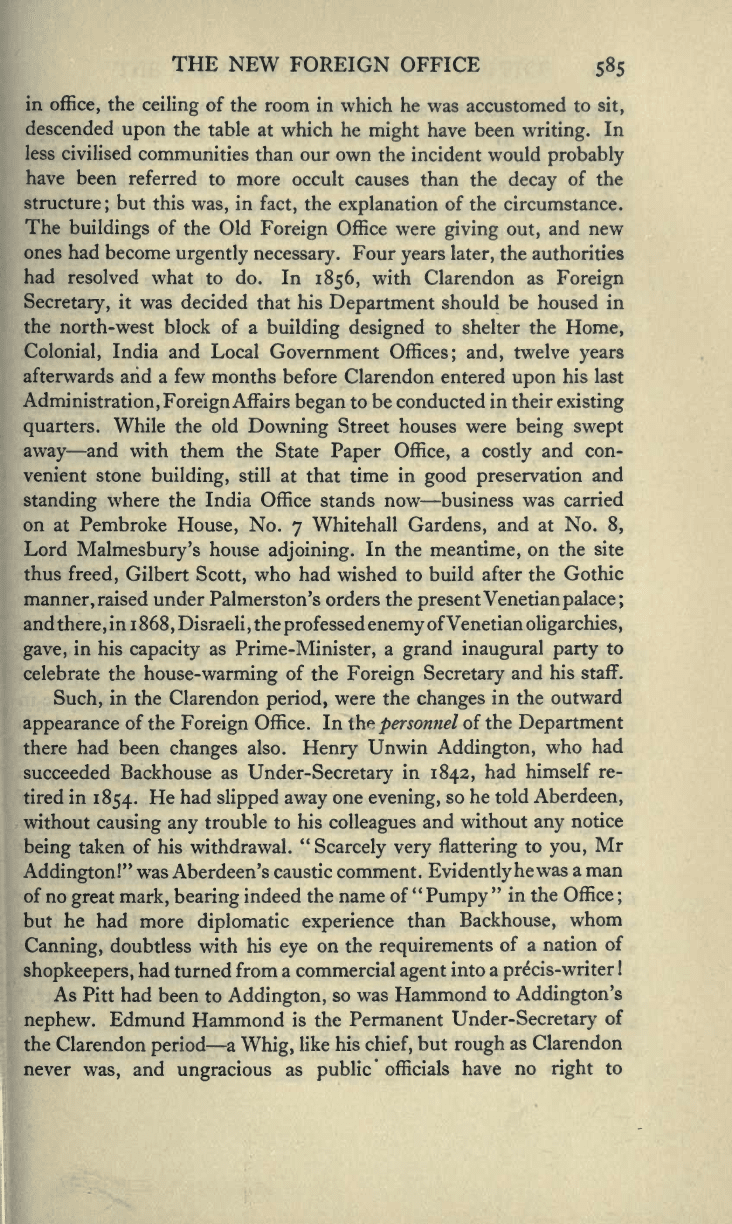
THE NEW
FOREIGN
OFFICE
585
in
office,
the
ceiling
of
the room in
which
he was accustomed to
sit,
descended
upon
the
table
at which
he
might
have been
writing.
In
less
civilised
communities
than
our
own
the incident would
probably
have
been
referred
to more
occult causes
than the
decay
of
the
structure;
but
this
was,
in
fact,
the
explanation
of
the circumstance.
The
buildings
of
the
Old
Foreign
Office
were
giving
out,
and new
ones had
become
urgently
necessary.
Four
years
later,
the authorities
had
resolved
what
to
do. In
1856,
with Clarendon
as
Foreign
Secretary,
it
was
decided
that
his
Department
should be housed
in
the
north-west block of
a
building
designed
to
shelter the
Home,
Colonial,
India and Local
Government
Offices;
and,
twelve
years
afterwards and
a few
months
before Clarendon entered
upon
his
last
Administration,
Foreign
Affairs
began
to
be
conducted
in
their
existing
quarters.
While
the
old
Downing
Street
houses were
being
swept
away
—
and
with them the
State
Paper
Office,
a
costly
and
con-
venient stone
building,
still at
that time
in
good preservation
and
standing
where
the
India Office
stands
now
—
business
was carried
on
at Pembroke
House,
No.
7
Whitehall
Gardens,
and
at
No.
8,
Lord
Malmesbury's
house
adjoining.
In
the
meantime,
on
the
site
thus
freed,
Gilbert
Scott,
who had wished
to
build after the
Gothic
manner,
raised under
Palmerston's
orders
the
present
Venetian
palace;
and
there,
in
1
868
,
Disraeli
,
the
professed
enemy
ofVenetian
oligarchies,
gave,
in
his
capacity
as
Prime-Minister,
a
grand
inaugural
party
to
celebrate
the
house-warming
of
the
Foreign
Secretary
and
his
staff.
Such,
in
the
Clarendon
period,
were the
changes
in
the
outward
appearance
of
the
Foreign
Office.
In
the
personnel
of the
Department
there
had
been
changes
also.
Henry
Unwin
Addington,
who
had
succeeded Backhouse
as
Under-Secretary
in
1842,
had himself
re-
tired
in
1854.
He
had
slipped away
one
evening,
so he told
Aberdeen,
without
causing any
trouble
to
his
colleagues
and
without
any
notice
being
taken of
his
withdrawal.
"Scarcely
very
flattering
to
you,
Mr
Addington!"
was Aberdeen's caustic
comment.
Evidently
he
was
a
man
of
no
great
mark,
bearing
indeed
the name
of
"
Pumpy
"
in
the
Office
;
but he had
more
diplomatic
experience
than
Backhouse,
whom
Canning,
doubtless with
his
eye
on
the
requirements
of a nation
of
shopkeepers,
had
turned
from a commercial
agent
into
a
precis-
writer
!
As
Pitt
had
been
to
Addington,
so
was
Hammond
to
Addington
's
nephew.
Edmund
Hammond
is
the
Permanent
Under-Secretary
of
the Clarendon
period
—
a
Whig,
like
his
chief,
but
rough
as Clarendon
never
was,
and
ungracious
as
public
officials
have
no
right
to
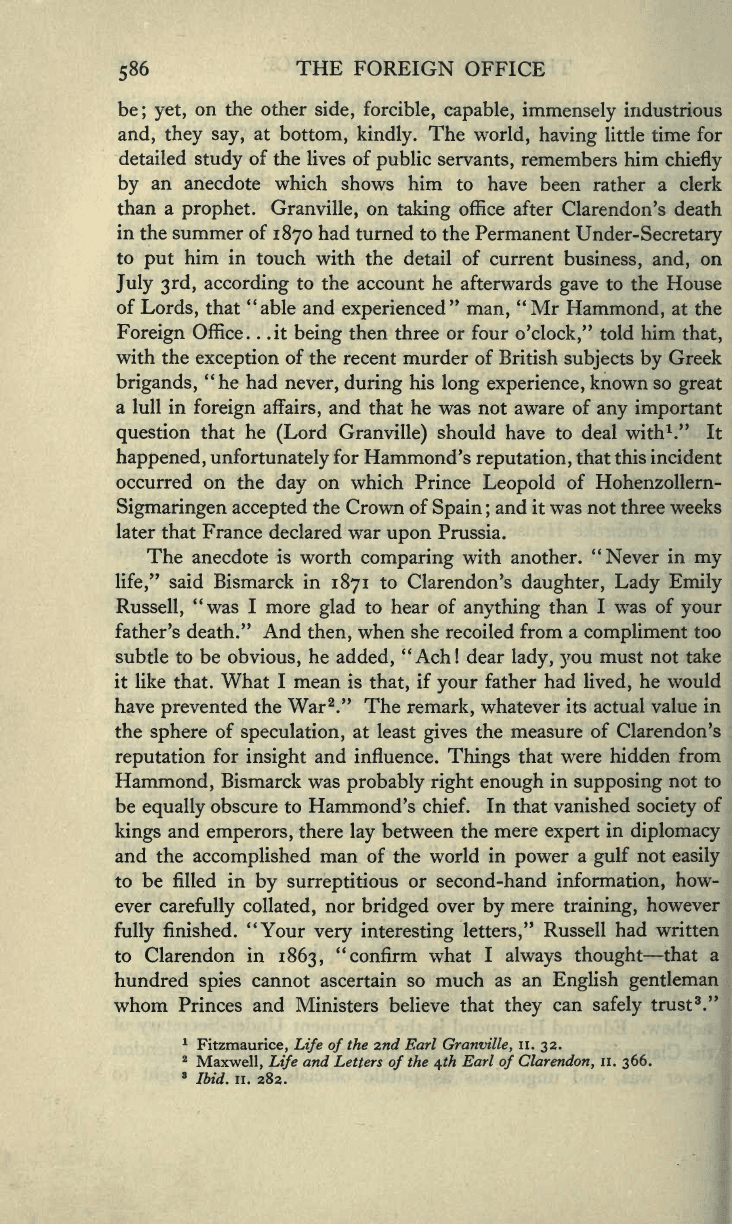
586
THE
FOREIGN
OFFICE
be;
yet,
on
the other
side,
forcible,
capable,
immensely
industrious
and,
they say,
at
bottom,
kindly.
The
world,
having
little
time
for
detailed
study
of
the lives of
public
servants,
remembers
him
chiefly
by
an
anecdote which
shows
him
to
have
been
rather
a
clerk
than
a
prophet.
Granville,
on
taking
office
after Clarendon's
death
in
the summer
of
1870
had
turned
to the Permanent
Under-Secretary
to
put
him in
touch
with the
detail
of
current
business,
and,
on
July 3rd,
according
to the
account he afterwards
gave
to the
House
of
Lords,
that "able
and
experienced
"
man,
"Mr
Hammond,
at the
Foreign
Office. .
.it
being
then
three
or four
o'clock,"
told
him
that,
with the
exception
of
the recent murder of
British
subjects by
Greek
brigands,
"he
had
never,
during
his
long experience,
known
so
great
a lull
in
foreign
affairs,
and
that he was
not aware
of
any
important
question
that
he
(Lord
Granville)
should
have to deal with
1
."
It
happened,
unfortunately
for
Hammond's
reputation,
that
this
incident
occurred on
the
day
on which
Prince
Leopold
of
Hohenzollern-
Sigmaringen accepted
the Crown of
Spain
;
and
it
was
not three
weeks
later that France declared
war
upon
Prussia.
The
anecdote
is
worth
comparing
with another.
"Never
in
my
life,"
said
Bismarck in
1871
to Clarendon's
daughter, Lady
Emily
Russell,
"was
I
more
glad
to
hear of
anything
than
I
was
of
your
father's
death."
And
then,
when she recoiled
from a
compliment
too
subtle to be
obvious,
he
added,
"Ach! dear
lady, 3
r
ou must not
take
it
like
that.
What
I mean is
that,
if
your
father
had
lived,
he would
have
prevented
the War
2
." The
remark,
whatever
its actual
value
in
the
sphere
of
speculation,
at
least
gives
the
measure of
Clarendon's
reputation
for
insight
and
influence.
Things
that
were
hidden
from
Hammond,
Bismarck was
probably right enough
in
supposing
not to
be
equally
obscure
to
Hammond's
chief.
In
that
vanished
society
of
kings
and
emperors,
there
lay
between the
mere
expert
in
diplomacy
and
the
accomplished
man
of the world
in
power
a
gulf
not
easily
to
be filled in
by surreptitious
or second-hand
information,
how-
ever
carefully
collated,
nor
bridged
over
by
mere
training,
however
fully
finished. "Your
very interesting
letters,"
Russell
had
written
to
Clarendon
in
1863,
"confirm
what
I
always
thought
—
that
a
hundred
spies
cannot
ascertain
so
much
as an
English
gentleman
whom Princes
and
Ministers
believe that
they
can
safely
trust
3
."
1
Fitzmaurice,
Life
of
the
2nd
Earl
Granville,
II,
32.
2
Maxwell,
Life
and
Letters
of
the
4th
Earl
of
Clarendon,
11.
366.
3
Ibid. 11.
282.

THE
MID-VICTORIAN
FOREIGN
OFFICE
587
The
system
of
privilege
which
formed
part
and
parcel
of
a
diplomatic
career in
the
nineteenth
century
possesses,
and
perhaps
requires,
no
better
defence.
Hammond
retired from
work
in
1873
w
*
tn
a
peerage
1
,
and
a
pension
of
£2500.
Towards
the close of his
career,
a
bust,
which
faces
the
fine
marble
staircase
of
the
new
Foreign
Office,
was
put
up
in his
honour.
It satisfies a
nice
sense
of
proportion
that
within
view
there stands
also
a
full-length
statue
of
Clarendon.
Of
the
witnesses
who
appeared
before the
Select
Committee
on
the
Diplomatic
Service,
which
sat
in
1861,
Hammond and
Clarendon
were
among
the
most
important
;
and
their evidence furnishes a com-
prehensive
view
of
the
Foreign
Office
and
the
Diplomatic
Service
as
they appeared
in
the
middle of
the
nineteenth
century.
Hammond's
Memorandum
drawn
up
for
the
Committee on
the
organisation
of
the
Office,
is, indeed,
a
primary
authority
for
this
period
of
its
history.
At the
apex
of
the
structure
stood,
of
course,
the
Foreign
Minister
with
his
Private
Secretary,
the
latter not
yet
quite
so
influential
a
person
as
he was
later to become.
Next
after the
Foreign
Secretary
followed
the two
Under-Secretaries. These
cannot
be
sufficiently
distinguished
from
each
other,
though
old
Foreign
Office Lists class
them
together
as if their
relation had been
of
the
closest. One
was a
permanent
and
a
public
official
;
the
other,
a
Member
of
Parliament,
subject,
like
other
politicians,
to the
changes
and
chances
of
political
fortune.
Though they
stood
upon
a
supposed
equality,
there
was
no
comparison
in
their
influence,
since
the
one knew his
work
and
the other had
to
learn
it;
nor
was
there
any similarity
in
their
aims,
since
the Permanent
Under-Secretary,
with
his
eye
upon
Foreign
Governments,
best attained
his
ends
by
suppressing
all
mention
of
successes,
while
the
Parliamentary
Under-Secretary,
with
his
eye upon
Parliament,
was
hardly
less
concerned to
advertise the
triumphs
of
his Chiefs
diplomacy.
The work of these
ill-paired
functionaries,
each
controlling,
as
he
did
at
this
time,
one
half of
the
business
of
the
Office,
and
drafting
the
despatches
relating
to
that
half in
accordance with
the
Secretary
of
State's
minutes,
was
con-
nected
always
by
formal,
and
at
will
by
informal,
means.
In
the
course of
its
many peregrinations,
each
despatch-box,
just
before
it
found
its
way
to
the
Prime-Minister,
was
required
to
pass
through
the hands of
the
Under-Secretary
not
directly
concerned with the
affairs of
the
country
to
which the contents
of
the
box related.
But,
1
Conferred
in
1874.
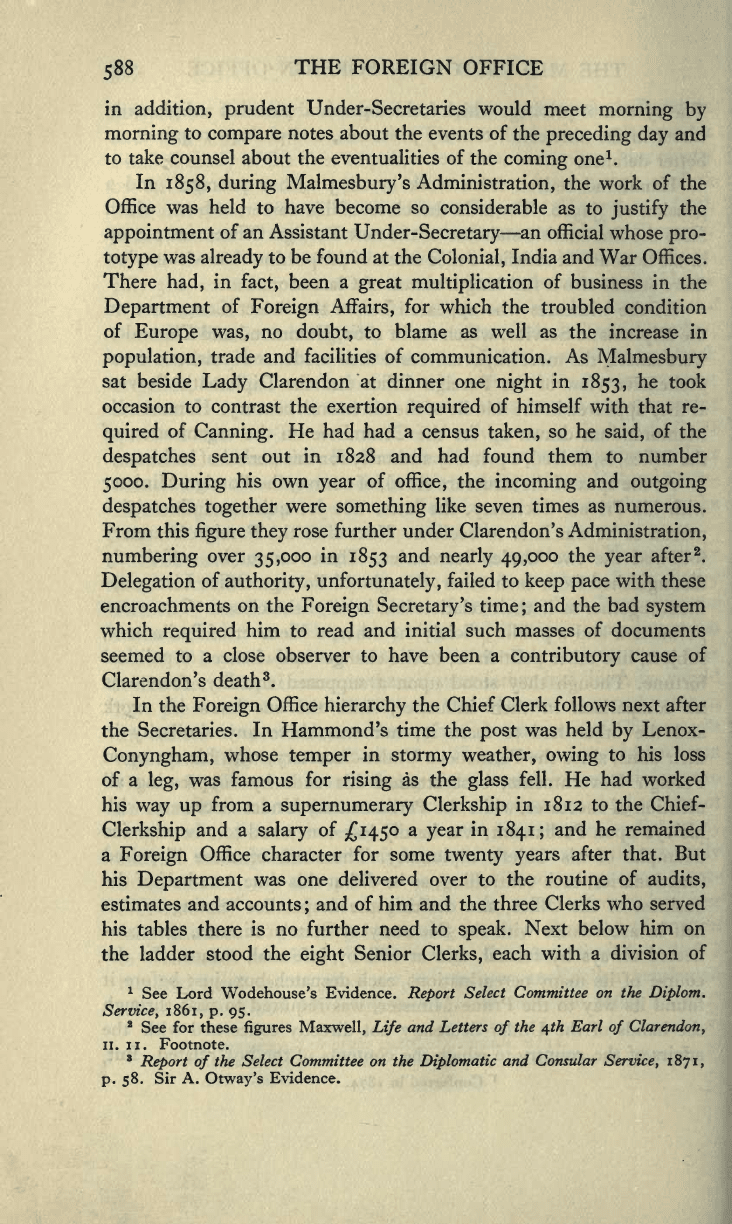
588
THE
FOREIGN
OFFICE
in
addition,
prudent
Under-Secretaries would
meet
morning by
morning
to
compare
notes about the events of
the
preceding day
and
to
take
counsel
about the eventualities
of
the
coming
one
1
.
In
1858, during Malmesbury's
Administration,
the work of
the
Office was held
to
have
become so considerable as
to
justify
the
appointment
of an
Assistant
Under-Secretary
—
an
official
whose
pro-
totype
was
already
to
be found
at the
Colonial,
India and
War Offices.
There
had,
in
fact,
been a
great
multiplication
of
business in
the
Department
of
Foreign
Affairs,
for
which
the troubled
condition
of
Europe
was,
no
doubt,
to blame
as
well
as
the
increase in
population,
trade
and
facilities
of
communication.
As
Malmesbury
sat beside
Lady
Clarendon
at
dinner
one
night
in
1853,
ne
t0
°k
occasion
to contrast the exertion
required
of
himself
with that
re-
quired
of
Canning.
He
had
had a
census
taken,
so
he
said,
of
the
despatches
sent
out
in
1828 and had found them
to
number
5000. During
his own
year
of
office,
the
incoming
and
outgoing
despatches together
were
something
like seven times
as
numerous.
From
this
figure they
rose
further
under
Clarendon's
Administration,
numbering
over
35,000
in
1853
and
nearly
49,000
the
year
after
2
.
Delegation
of
authority, unfortunately,
failed
to
keep
pace
with these
encroachments
on the
Foreign
Secretary's
time
;
and
the
bad
system
which
required
him
to read
and initial such masses of
documents
seemed to
a close observer to have been a
contributory
cause
of
Clarendon's death
3
.
In
the
Foreign
Office
hierarchy
the
Chief
Clerk follows
next after
the
Secretaries.
In
Hammond's time the
post
was held
by
Lenox-
Conyngham,
whose
temper
in
stormy
weather,
owing
to
his
loss
of a
leg,
was
famous
for
rising
as
the
glass
fell.
He
had worked
his
way
up
from a
supernumerary Clerkship
in
18
12 to the
Chief-
Clerkship
and a
salary
of
£1450
a
year
in
1841
;
and he
remained
a
Foreign
Office
character
for
some
twenty
years
after that.
But
his
Department
was one delivered over
to
the routine
of
audits,
estimates
and
accounts
;
and of
him
and
the
three
Clerks who served
his
tables there
is no
further
need
to
speak.
Next below
him
on
the
ladder
stood the
eight
Senior
Clerks,
each with
a division of
1
See Lord
Wodehouse's Evidence.
Report
Select
Committee on the
Diplom.
Service, 1861, p. 95.
2
See for these
figures
Maxwell,
Life
and
Letters
of
the
4th
Earl
of
Clarendon,
H.
11. Footnote.
8
Report
of
the Select Committee on the
Diplomatic
and
Consular
Service,
1871,
p.
58.
Sir A.
Otway's
Evidence.
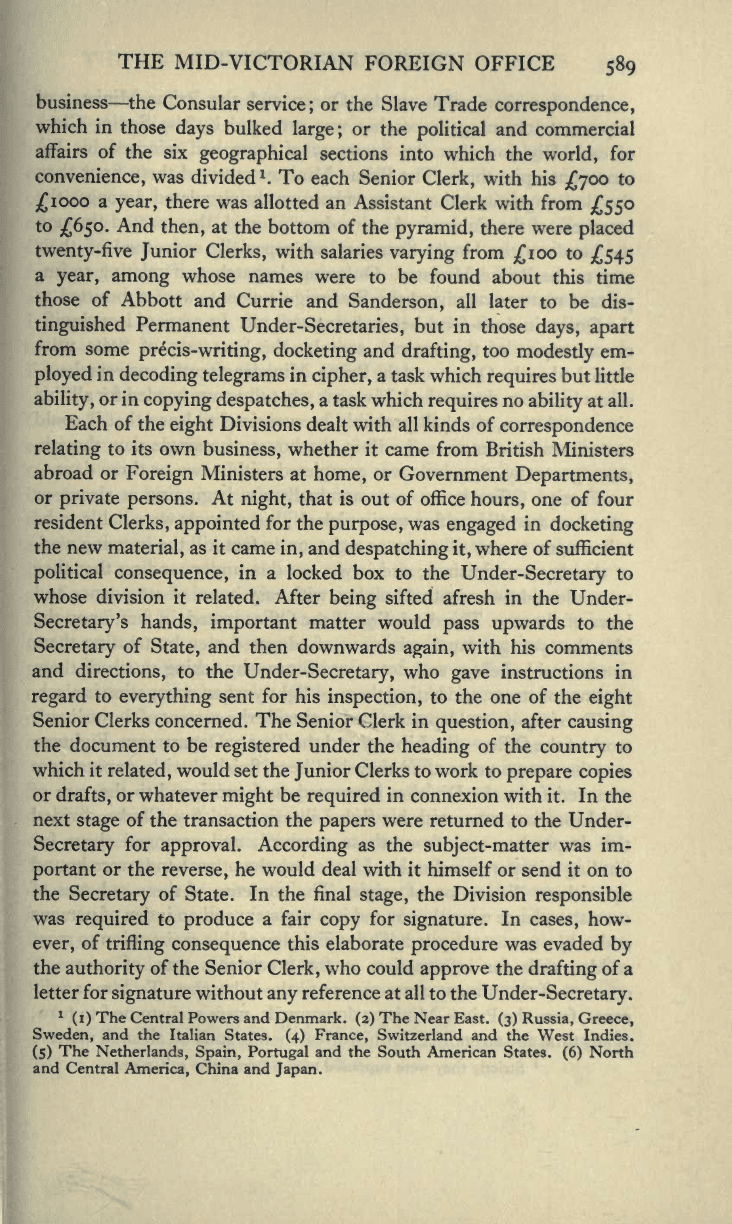
THE
MID-VICTORIAN
FOREIGN
OFFICE
589
business
—
the
Consular
service;
or
the Slave
Trade
correspondence,
which in
those
days
bulked
large;
or
the
political
and commercial
affairs of
the
six
geographical
sections
into which
the
world,
for
convenience,
was
divided
l
.
To each
Senior
Clerk,
with
his
£700
to
£1000
a
year,
there was
allotted an
Assistant
Clerk with from
£550
t0
£650.
And
then,
at
the
bottom of
the
pyramid,
there were
placed
twenty-five
Junior Clerks,
with
salaries
varying
from
£100
to
£545
a
year,
among
whose
names
were
to be found
about
this time
those
of
Abbott and
Currie and
Sanderson,
all
later
to be
dis-
tinguished
Permanent
Under-Secretaries,
but
in
those
days,
apart
from some
precis-
writing,
docketing
and
drafting,
too
modestly
em-
ployed
in
decoding
telegrams
in
cipher,
a
task which
requires
but
little
ability,
or in
copying despatches,
a
task
which
requires
no
ability
at
all.
Each of
the
eight
Divisions
dealt
with
all
kinds of
correspondence
relating
to its own
business,
whether
it came from
British Ministers
abroad or
Foreign
Ministers
at
home,
or
Government
Departments,
or
private
persons.
At
night,
that
is
out
of
office
hours,
one of four
resident
Clerks,
appointed
for
the
purpose,
was
engaged
in
docketing
the
new
material,
as
it came
in,
and
despatching
it,
where of
sufficient
political
consequence,
in a
locked
box
to the
Under-Secretary
to
whose
division
it related.
After
being
sifted afresh
in
the
Under-
Secretary's
hands,
important
matter would
pass upwards
to the
Secretary
of
State,
and
then downwards
again,
with his
comments
and
directions,
to
the
Under-Secretary,
who
gave
instructions
in
regard
to
everything
sent
for
his
inspection,
to the one
of
the
eight
Senior Clerks
concerned. The
Senior
Clerk
in
question,
after
causing
the
document
to be
registered
under
the
heading
of
the
country
to
which
it
related,
would
set
the
Junior
Clerks
to
work
to
prepare
copies
or
drafts,
or
whatever
might
be
required
in
connexion
with it.
In
the
next
stage
of
the transaction the
papers
were
returned
to the
Under-
Secretary
for
approval.
According
as
the
subject-matter
was im-
portant
or
the
reverse,
he would deal
with it
himself
or
send it
on
to
the
Secretary
of
State.
In
the
final
stage,
the Division
responsible
was
required
to
produce
a fair
copy
for
signature.
In
cases,
how-
ever,
of
trifling consequence
this elaborate
procedure
was evaded
by
the
authority
of
the
Senior
Clerk,
who could
approve
the
drafting
of a
letter for
signature
without
any
reference
at all
to the
Under-Secretary.
1
(1)
The
Central
Powers
and Denmark.
(2)
The
Near East.
(3)
Russia,
Greece,
Sweden,
and
the
Italian
States.
(4)
France,
Switzerland
and
the
West Indies.
(5)
The
Netherlands,
Spain, Portugal
and
the
South
American States.
(6)
North
and
Central
America,
China and
Japan.
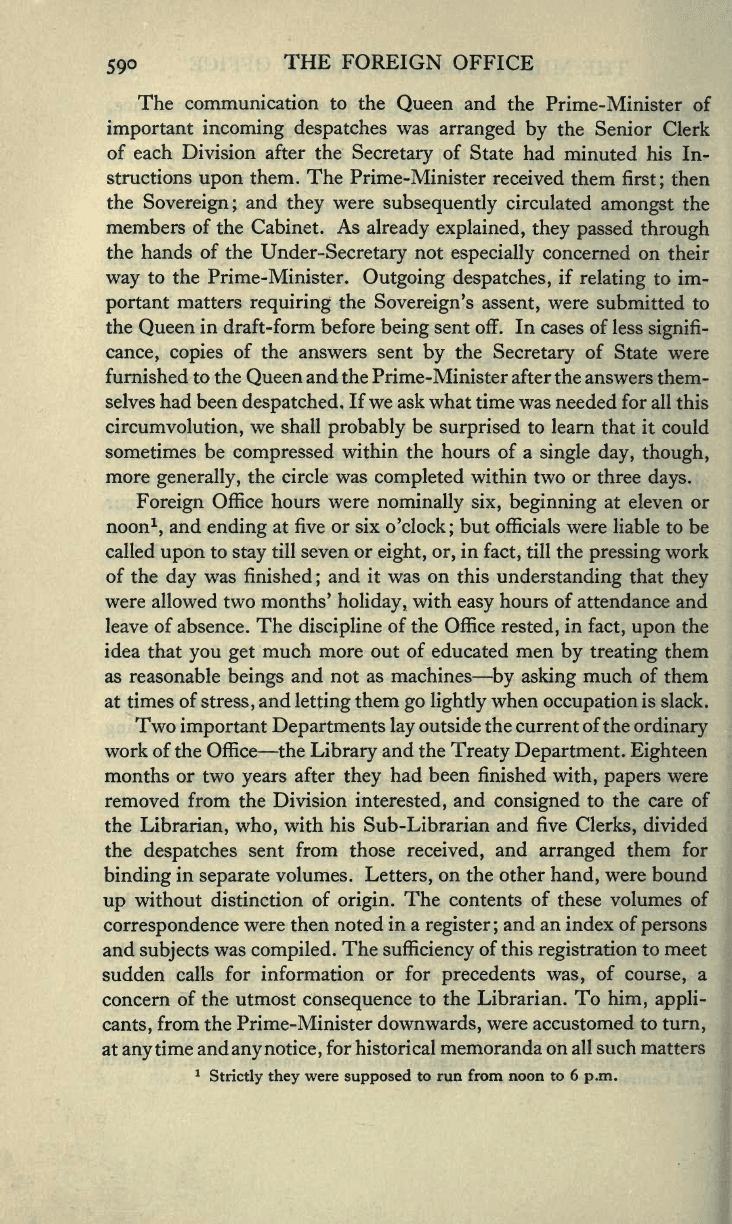
590
THE
FOREIGN
OFFICE
The
communication
to the
Queen
and
the
Prime-Minister of
important
incoming despatches
was
arranged
by
the Senior
Clerk
of each
Division
after the
Secretary
of
State had
minuted
his
In-
structions
upon
them.
The
Prime-Minister received
them
first;
then
the
Sovereign;
and
they
were
subsequently
circulated
amongst
the
members of
the
Cabinet.
As
already explained,
they
passed
through
the
hands of
the
Under-Secretary
not
especially
concerned on
their
way
to the Prime-Minister.
Outgoing despatches,
if
relating
to
im-
portant
matters
requiring
the
Sovereign's
assent,
were
submitted to
the
Queen
in
draft-form before
being
sent off.
In
cases
of
less
signifi-
cance,
copies
of
the answers sent
by
the
Secretary
of
State were
furnished
to the
Queen
and
the Prime-Minister
after the answers
them-
selves had been
despatched.
If
we ask
what time was
needed
for
all
this
circumvolution,
we shall
probably
be
surprised
to learn
that it could
sometimes
be
compressed
within
the
hours of
a
single day,
though,
more
generally,
the circle was
completed
within two
or
three
days.
Foreign
Office
hours were
nominally
six,
beginning
at eleven or
noon
1
,
and
ending
at
five
or
six
o'clock;
but
officials
were
liable to be
called
upon
to
stay
till seven
or
eight,
or,
in
fact,
till the
pressing
work
of
the
day
was
finished
;
and
it
was on
this
understanding
that
they
were allowed
two months'
holiday,
with
easy
hours
of
attendance and
leave
of
absence.
The
discipline
of
the Office
rested,
in
fact,
upon
the
idea
that
you get
much more
out
of
educated
men
by treating
them
as reasonable
beings
and
not
as
machines
—
by
asking
much of
them
at times
of
stress,
and
letting
them
go lightly
when
occupation
is
slack.
Two
important
Departments
lay
outside the current
of
the
ordinary
work of
the
Office
—
the
Library
and
the
Treaty Department.
Eighteen
months
or
two
years
after
they
had
been
finished
with,
papers
were
removed
from
the
Division
interested,
and
consigned
to the care
of
the
Librarian, who,
with
his Sub-Librarian
and
five
Clerks,
divided
the
despatches
sent
from
those
received,
and
arranged
them
for
binding
in
separate
volumes.
Letters,
on
the other
hand,
were bound
up
without
distinction
of
origin.
The contents
of
these
volumes of
correspondence
were then
noted
in a
register
;
and an
index
of
persons
and
subjects
was
compiled.
The
sufficiency
of
this
registration
to
meet
sudden calls
for
information
or for
precedents
was,
of
course,
a
concern
of
the
utmost
consequence
to
the
Librarian. To
him,
appli-
cants,
from the
Prime-Minister
downwards,
were
accustomed to
turn,
at
anytime
and
any
notice,
for
historical
memoranda on all
such
matters
1
Strictly
they
were
supposed
to
run
from
noon to
6
p.m.
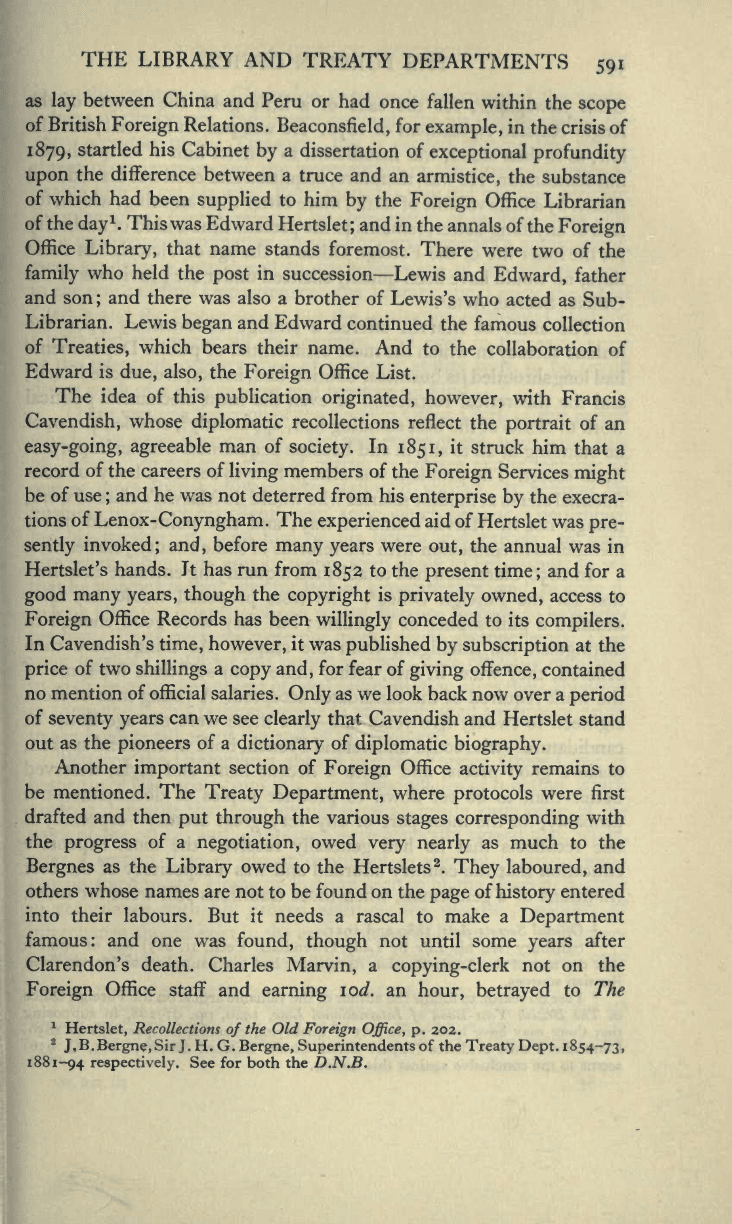
THE LIBRARY
AND
TREATY
DEPARTMENTS
591
as
lay
between
China and
Peru or
had
once
fallen
within
the
scope
of British
Foreign
Relations.
Beaconsfield,
for
example,
in
the crisis
of
1879,
startled
his
Cabinet
by
a
dissertation of
exceptional
profundity
upon
the
difference
between
a
truce and
an
armistice,
the
substance
of
which had
been
supplied
to
him
by
the
Foreign
Office
Librarian
of the
day
1
.
Thiswas
Edward
Hertslet;
and
in
the annals of
the
Foreign
Office
Library,
that name
stands
foremost.
There were
two of
the
family
who
held
the
post
in
succession
—
Lewis
and
Edward,
father
and son
;
and
there
was also
a
brother of
Lewis's
who
acted as Sub-
Librarian.
Lewis
began
and
Edward
continued
the
famous
collection
of
Treaties,
which
bears
their
name.
And
to
the
collaboration
of
Edward is
due, also,
the
Foreign
Office List.
The idea of
this
publication
originated,
however,
with
Francis
Cavendish,
whose
diplomatic
recollections
reflect
the
portrait
of an
easy-going, agreeable
man of
society.
In
1851,
it struck
him
that a
record
of
the
careers of
living
members
of
the
Foreign
Services
might
be
of use
;
and he was
not
deterred from
his
enterprise
by
the execra-
tions
of Lenox-
Cony
ngham.
The
experienced
aid
of
Hertslet was
pre-
sently
invoked;
and,
before
many years
were
out,
the annual
was in
Hertslet's
hands. Jt has run from
1852
to the
present
time
;
and
for a
good many
years,
though
the
copyright
is
privately
owned,
access
to
Foreign
Office Records has
been
willingly
conceded
to
its
compilers.
In Cavendish's
time,
however,
it
was
published
by
subscription
at the
price
of two
shillings
a
copy
and,
for
fear of
giving
offence,
contained
no
mention
of official salaries.
Only
as
we look
back now
over a
period
of
seventy years
can
we see
clearly
that Cavendish and
Hertslet stand
out
as
the
pioneers
of a
dictionary
of
diplomatic
biography.
Another
important
section of
Foreign
Office
activity
remains
to
be
mentioned.
The
Treaty Department,
where
protocols
were first
drafted
and
then
put
through
the various
stages corresponding
with
the
progress
of a
negotiation,
owed
very nearly
as much
to the
Bergnes
as
the
Library
owed
to the Hertslets
2
.
They
laboured,
and
others
whose
names are
not
to
be found
on
the
page
of
history
entered
into
their labours.
But it
needs a
rascal
to
make
a
Department
famous: and
one was
found,
though
not until
some
years
after
Clarendon's
death.
Charles
Marvin,
a
copying-clerk
not
on the
Foreign
Office
staff
and
earning
lod.
an
hour,
betrayed
to
The
1
Hertslet,
Recollections
of
the
Old
Foreign Office,
p.
202.
2
J.B.Bergne,Sir
J.
H.
G.
Bergne,
Superintendents
of the
Treaty Dept. 1854-73,
1881-94
respectively.
See for both the D.N.B.
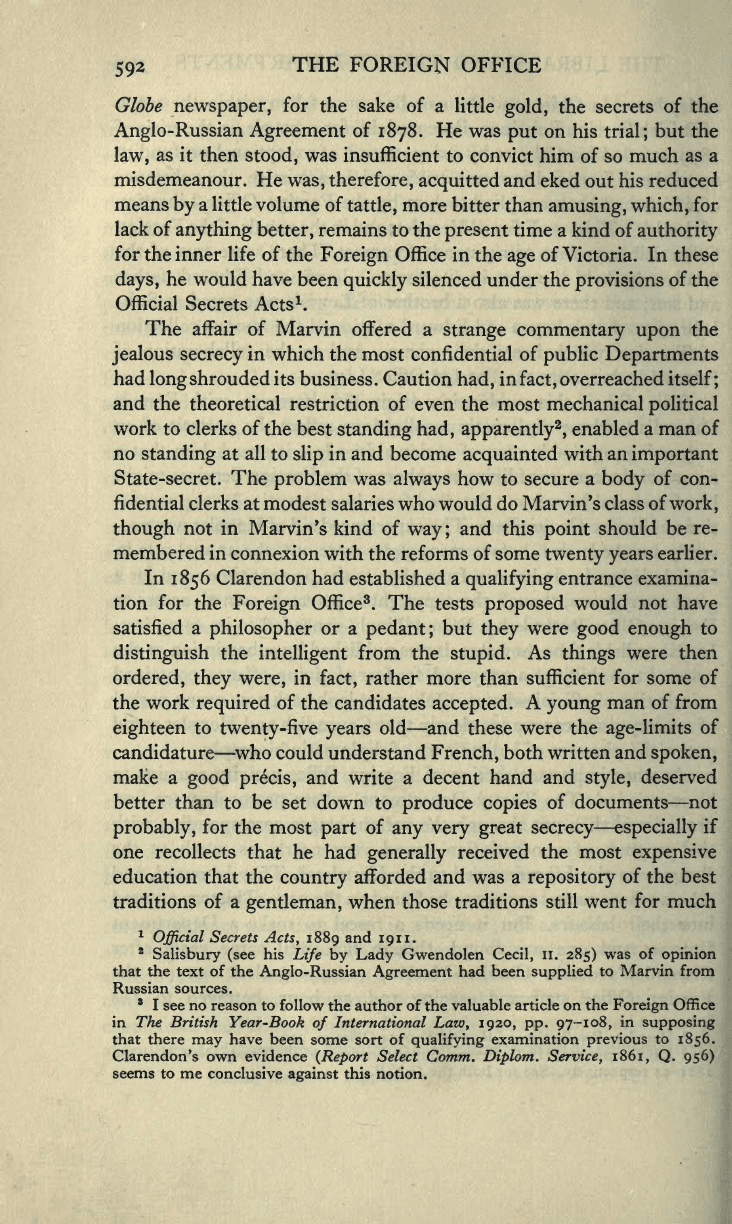
592
THE FOREIGN
OFFICE
Globe
newspaper,
for
the
sake of a
little
gold,
the
secrets
of
the
Anglo-Russian Agreement
of
1878.
He
was
put
on his
trial;
but
the
law,
as
it then
stood,
was
insufficient to
convict
him
of so
much
as a
misdemeanour. He
was, therefore,
acquitted
and
eked
out
his reduced
means
by
a
little volume of
tattle,
more
bitter than
amusing,
which,
for
lack of
anything
better,
remains
to
the
present
time a kind
of
authority
for
the
inner
life of
the
Foreign
Office in
the
age
of
Victoria.
In
these
days,
he would
have been
quickly
silenced
under
the
provisions
of
the
Official
Secrets
Acts
1
.
The affair
of
Marvin offered a
strange
commentary upon
the
jealous secrecy
in
which
the
most confidential
of
public Departments
had
long
shrouded
its
business.
Caution
had,
in
fact,
overreached
itself;
and
the theoretical
restriction
of even
the most
mechanical
political
work to clerks of
the
best
standing
had,
apparently
2
,
enabled
a man of
no
standing
at
all
to
slip
in and
become
acquainted
with
an
important
State-secret. The
problem
was
always
how
to
secure
a
body
of con-
fidential clerks
at
modest
salaries who would do
Marvin's class
of
work,
though
not
in
Marvin's kind of
way
;
and
this
point
should
be
re-
membered
in
connexion
with the reforms
of some
twenty years
earlier.
In
1856
Clarendon had
established
a
qualifying
entrance
examina-
tion
for
the
Foreign
Office
3
. The
tests
proposed
would
not
have
satisfied
a
philosopher
or
a
pedant;
but
they
were
good
enough
to
distinguish
the
intelligent
from
the
stupid.
As
things
were then
ordered,
they
were,
in
fact,
rather more
than
sufficient
for some of
the
work
required
of
the candidates
accepted.
A
young
man of from
eighteen
to
twenty-five
years
old
—
and
these
were
the
age-limits
of
candidature
—
who could
understand
French,
both written
and
spoken,
make
a
good precis,
and
write
a
decent
hand and
style,
deserved
better
than
to
be
set
down
to
produce
copies
of documents
—
not
probably,
for
the
most
part
of
any very
great
secrecy
—
especially
if
one recollects
that
he had
generally
received the
most
expensive
education that the
country
afforded
and was
a
repository
of
the
best
traditions
of a
gentleman,
when
those traditions
still
went
for much
1
Official
Secrets
Acts,
1889
and
191
1.
2
Salisbury
(see
his
Life by Lady
Gwendolen
Cecil,
II.
285)
was of
opinion
that
the
text
of the
Anglo-Russian
Agreement
had been
supplied
to
Marvin from
Russian
sources.
3
I
see
no
reason to follow
the
author
of
the valuable
article
on the
Foreign
Office
in The
British Year-Book
of
International
Law,
1920, pp.
97-108,
in
supposing
that
there
may
have been
some sort of
qualifying
examination
previous
to
1856.
Clarendon's own evidence
(Report
Select Comm.
Diplom.
Service,
1861,
Q.
956)
seems to me
conclusive
against
this
notion.

FOREIGN
OFFICE
AGENCIES
593
in
public
estimation.
Clarendon
perceived
and
resented the
waste-
fulness
of
the
system,
and
fought
zealously
for
his Clerks
against
the
petty
economy
of
the
Treasury.
But
it
needed
nothing
less
than a
threat
of
resignation
and
the
intervention
of
the
Prime-Minister to
enable him
to
get
his
way.
Even
then,
his
way
did
not
lead
very
far.
Supplementary
Clerks,
selected
by
competition
or
in
some
cases
only
by
a
qualifying
examination
on
the
Foreign
Secretary's
nomination
1
,
were
grudgingly
introduced
to
discharge
some of
the
routine
work
in
the
non-political
Departments
—
the
Library,
the
Treaty,
the Chief
Clerk's and
the
Commercial
;
but the institution
of
Second
Division
Clerks did
not occur
till the
'eighties,
and
even in
the
early years
of
the
twentieth
century
men of
first-rate
ability
were
to be found
doing
work of
a
very
modest
and
mechanical kind.
There was
one
function of
the
Foreign
Office
Clerk
of
this
period
which
has
since
disappeared.
He was
accustomed,
under
the
title
of
"agent,"
to
act
as
a kind
of
patron
or
trustee
of
the
fortunes of
one or
more
British
diplomatists
stationed
abroad.
It
became his
business
to
collect
his
client's
pay,
from
which he
took
a
percentage
for his
trouble;
to
send him
on his
letters
and
parcels;
to
warn
him
when
diplomatic
appointments
were
likely
to
fall
vacant
;
to
see
that he was
not
passed
over for lack of
remembrance
; and,
in
a
word,
to
look
after
the
interests of one whom
distance
forbade
to
look
after
his
own. These
agencies
were
not mere
private
arrangements.
They
were
legalised
by
Order
in
Council
in
1795,
were
officially regulated
in
1816,
became
the
subject
of
legal
compensation
after their abolition
in
1870,
and in
this
fashion
appear
to
have
remained a source of
profit
to the
holders
till
about the end of the
century
2
.
Between the
Diplomatist
abroad and
the
Foreign
Office
Clerk
at
home
there
was,
apart
from
this,
a
correspondence
of
function,
which
made
it desirable
that each
should
have
an inside
knowledge
of the
work of
the
other;
and
authorities
were
generally agreed
that,
while,
after a
certain
time
of
life or
degree
of
promotion,
a
man should
remain
fixed in
the Home or
Foreign
section
of
the
Foreign
Service
in
accordance
with his
proved
abilities,
the utmost
possibility
of
interchange
should
exist
in
the
earlier
stages
of his career.
And
inter-
change,
though
not
properly
compulsory
until
1862
8
—
and then
only
1
4th
Report
Civil
Establ. Comm.
1890,
Qs.
26,006,
26,007.
2
See
Report
Select
Comm.
Diplom.
Service, 1861,
Min.
of
Ev.,
p.
192,
and
4th
Report
Civil
Establ.
Comm.
1890,
Min. of
Ev.,
Qs.
26,547
to
26,553.
3
5th
Report
Civil
Service Comm.
1914, p. 4. Cp. 4th
Report
Civil Establ.
Comm.
1890,
p.
8.
w.&G.in
38
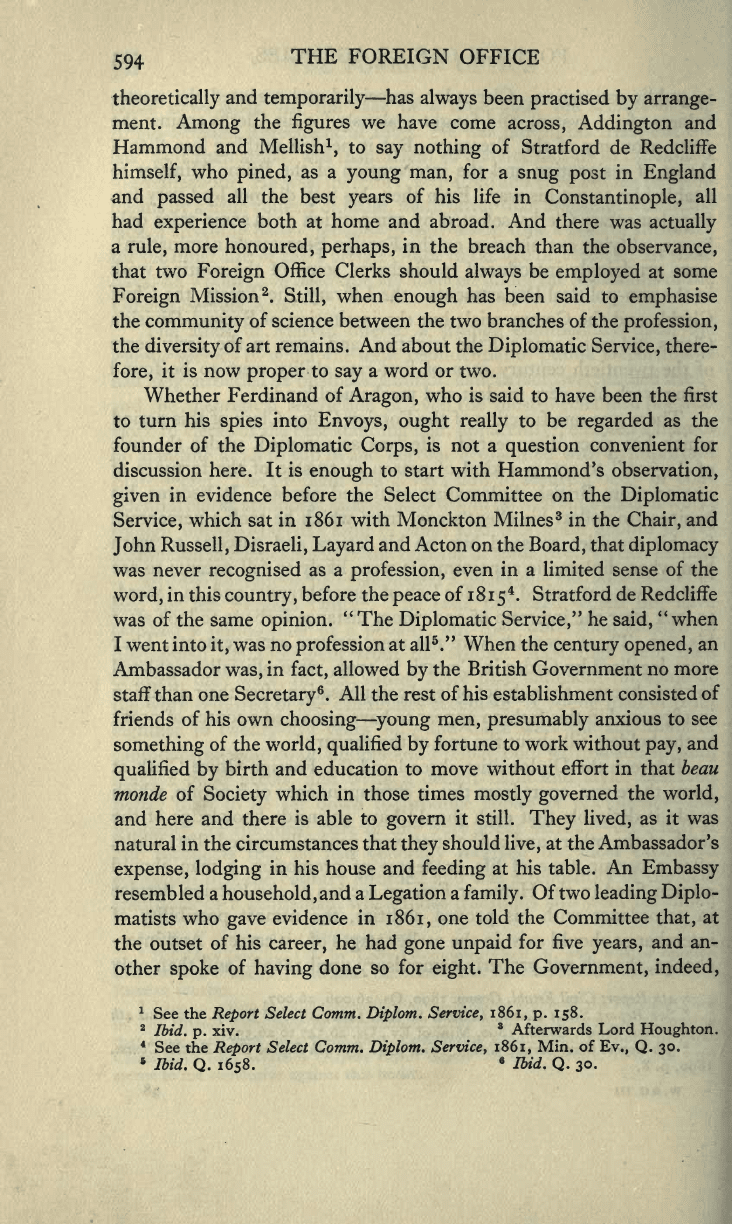
594
THE
FOREIGN
OFFICE
theoretically
and
temporarily
—
has
always
been
practised
by arrange-
ment.
Among
the
figures
we have come
across,
Addington
and
Hammond
and
Mellish
1
,
to
say
nothing
of
Stratford de
Redcliffe
himself,
who
pined,
as a
young
man,
for a
snug post
in
England
and
passed
all
the best
years
of his
life
in
Constantinople,
all
had
experience
both
at
home
and abroad.
And
there was
actually
a
rule,
more
honoured,
perhaps,
in
the breach
than
the
observance,
that
two
Foreign
Office
Clerks
should
always
be
employed
at
some
Foreign
Mission
2
.
Still,
when
enough
has
been said
to
emphasise
the
community
of science between the
two
branches of
the
profession,
the
diversity
of
art
remains.
And
about
the
Diplomatic
Service,
there-
fore,
it
is
now
proper
to
say
a word
or
two.
Whether
Ferdinand of
Aragon,
who
is
said
to have
been
the
first
to
turn
his
spies
into
Envoys, ought
really
to
be
regarded
as
the
founder of the
Diplomatic
Corps,
is
not
a
question
convenient
for
discussion here.
It
is
enough
to
start
with
Hammond's
observation,
given
in evidence before
the Select Committee
on
the
Diplomatic
Service,
which
sat
in
1861 with Monckton
Milnes
3
in
the
Chair,
and
John
Russell,
Disraeli,
Layard
and
Acton on
the
Board,
that
diplomacy
was never
recognised
as a
profession,
even
in
a limited sense
of
the
word,
in
this
country,
before
the
peace
of
1815
4
.
Stratford
de
Redcliffe
was
of
the
same
opinion.
"
The
Diplomatic
Service,"
he
said,
"
when
I
went
into
it,
was no
profession
at all
5
."
When
the
century
opened,
an
Ambassador
was,
in
fact,
allowed
by
the British
Government
no
more
staff than
one
Secretary
6
.
All
the
rest
of his
establishment
consisted
of
friends
of his own
choosing
—
young
men,
presumably
anxious to
see
something
of
the
world,
qualified by
fortune to
work
without
pay,
and
qualified
by
birth
and
education
to move without
effort
in
that
beau
monde
of
Society
which in
those times
mostly
governed
the
world,
and
here and there
is
able
to
govern
it still.
They
lived,
as
it
was
natural in
the
circumstances that
they
should
live,
at the
Ambassador's
expense, lodging
in his house and
feeding
at his table.
An
Embassy
resembled a
household,
and a
Legation
a
family.
Of
two
leading
Diplo-
matists
who
gave
evidence
in
1861,
one told the
Committee
that,
at
the
outset
of his
career,
he had
gone
unpaid
for five
years,
and
an-
other
spoke
of
having
done
so for
eight.
The
Government,
indeed,
1
See the
Report
Select Comm.
Diplom.
Service, 1861,
p.
158.
2
Ibid.
p.
xiv.
3
Afterwards
Lord
Houghton.
4
See the
Report
Select Comm.
Diplom.
Service, 1861,
Min.
of
Ev.,
Q.
30.
6
Ibid.
Q.
1658.
fl
Ibid.
Q.
30.
